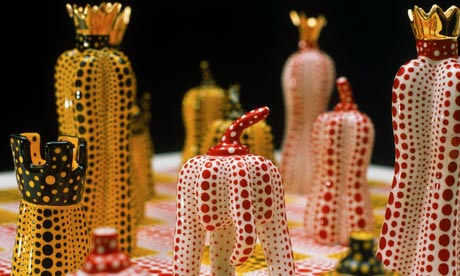Checkmates: how artists fell in love with chess
Knights, monarchs and pseudo-sacrifice – it's no wonder artists from Marcel Duchamp to Tracey Emin have been fascinated by chess, as a new exhibition shows


Detail of Yayoi Kusama's Pumpkin Chess in The Art of Chess. Photograph: Saatchi Gallery. Click for full image
The Art of Chess, which opens at London's Saatchi Gallery on Saturday, features chess sets designed by artists such as Tracey Emin andMaurizio Cattelan. The American artist Paul McCarthy has made a chess set from stuff he found in his kitchen. Tim Noble and Sue Webster have made one out of dead animals, with a tree stump as a chess board.
Why does this particular game have such a strong appeal for artists? The second-greatest artist of the 20th century, Marcel Duchamp, officially retired from art to become a competitive chess player, the first greatest,Picasso, preferred bullfighting). Duchamp wrote a book about chess endgames. He can be seen playing chess in René Clair's film Entr'acte.
It is not just artists who adore chess. Samuel Beckett's play Endgametakes its title from the same chess problems that fascinated Duchamp.Satyajit Ray's film The Chess Players uses chess to dramatise a moment in history on the eve of the Indian Mutiny in the 19th century. This is a game that pervades world culture.
Chess originates in India where a version of it was being played before the 6th century AD; within a few hundred years it spread to Europe. It is a game that creates an imaginative world, with powerful "characters": this must be why artists were inspired to create designer chess sets long before modern times. In the British Museum you can see ornately carved chess pieces from 7th century Samarkand as well as the famousmedieval Lewis Chessmen.
The modern chess sets in The Art of Chess are just the latest examples of this great game's perennial appeal to the imagination that has inspired everyone from medieval craftsmen to Yayoi Kusama.





No comments:
Post a Comment